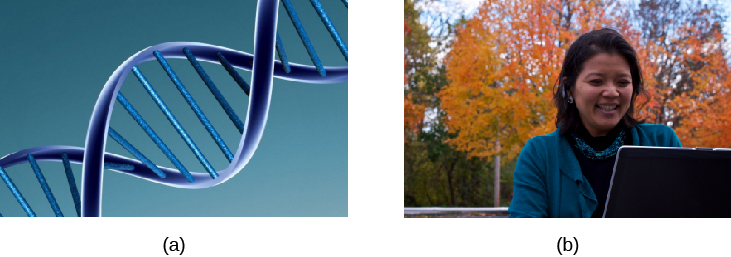| << Chapter < Page | Chapter >> Page > |
Genetic variation, the genetic difference between individuals, is what contributes to a species’ adaptation to its environment. In humans, genetic variation begins with an egg, about 100 million sperm, and fertilization. Fertile women ovulate roughly once per month, releasing an egg from follicles in the ovary. The egg travels, via the fallopian tube, from the ovary to the uterus, where it may be fertilized by a sperm.
The egg and the sperm each contain 23 chromosomes. Chromosomes are long strings of genetic material known as deoxyribonucleic acid (DNA) . DNA is a helix-shaped molecule made up of nucleotide base pairs. In each chromosome, sequences of DNA make up genes that control or partially control a number of visible characteristics, known as traits, such as eye color, hair color, and so on. A single gene may have multiple possible variations, or alleles. An allele is a specific version of a gene. So, a given gene may code for the trait of hair color, and the different alleles of that gene affect which hair color an individual has.
When a sperm and egg fuse, their 23 chromosomes pair up and create a zygote with 23 pairs of chromosomes. Therefore, each parent contributes half the genetic information carried by the offspring; the resulting physical characteristics of the offspring (called the phenotype) are determined by the interaction of genetic material supplied by the parents (called the genotype). A person’s genotype is the genetic makeup of that individual. Phenotype , on the other hand, refers to the individual’s inherited physical characteristics ( [link] ).

Most traits are controlled by multiple genes, but some traits are controlled by one gene. A characteristic like cleft chin , for example, is influenced by a single gene from each parent. In this example, we will call the gene for cleft chin “B,” and the gene for smooth chin “b.” Cleft chin is a dominant trait, which means that having the dominant allele either from one parent (Bb) or both parents (BB) will always result in the phenotype associated with the dominant allele. When someone has two copies of the same allele, they are said to be homozygous for that allele. When someone has a combination of alleles for a given gene, they are said to be heterozygous . For example, smooth chin is a recessive trait, which means that an individual will only display the smooth chin phenotype if they are homozygous for that recessive allele (bb).
Imagine that a woman with a cleft chin mates with a man with a smooth chin. What type of chin will their child have? The answer to that depends on which alleles each parent carries. If the woman is homozygous for cleft chin (BB), her offspring will always have cleft chin. It gets a little more complicated, however, if the mother is heterozygous for this gene (Bb). Since the father has a smooth chin—therefore homozygous for the recessive allele (bb)—we can expect the offspring to have a 50% chance of having a cleft chin and a 50% chance of having a smooth chin ( [link] ).

Notification Switch
Would you like to follow the 'Psychology' conversation and receive update notifications?